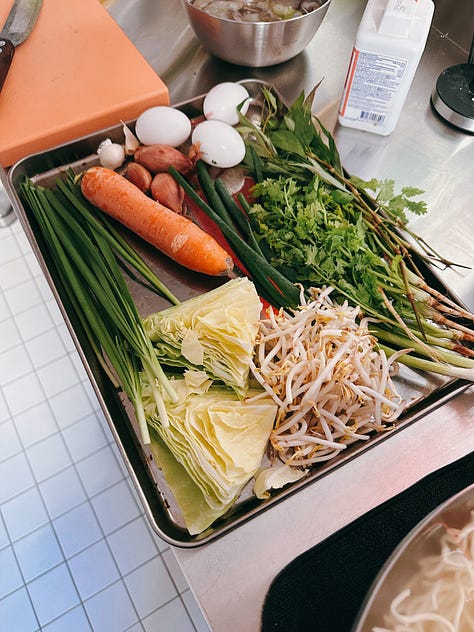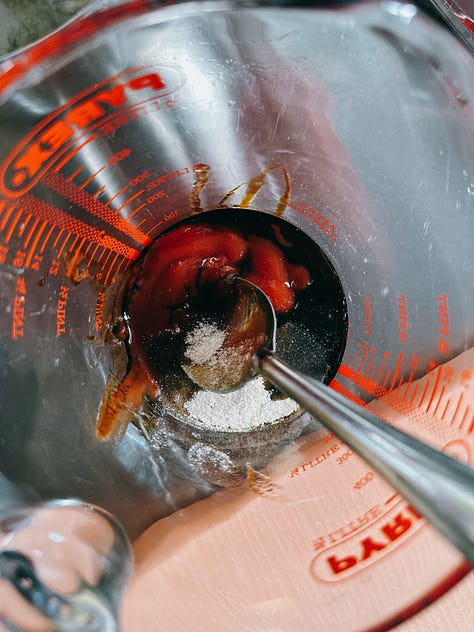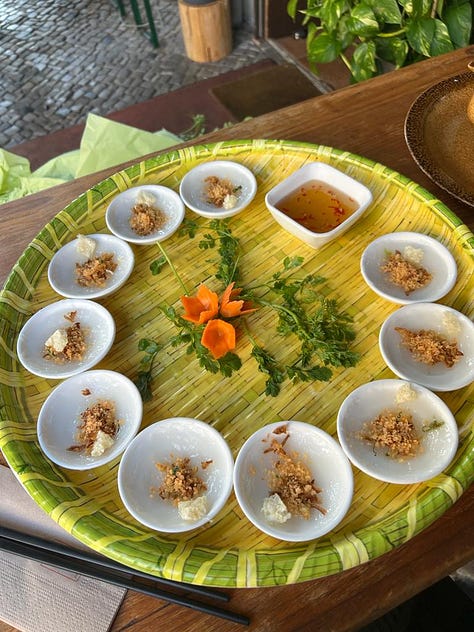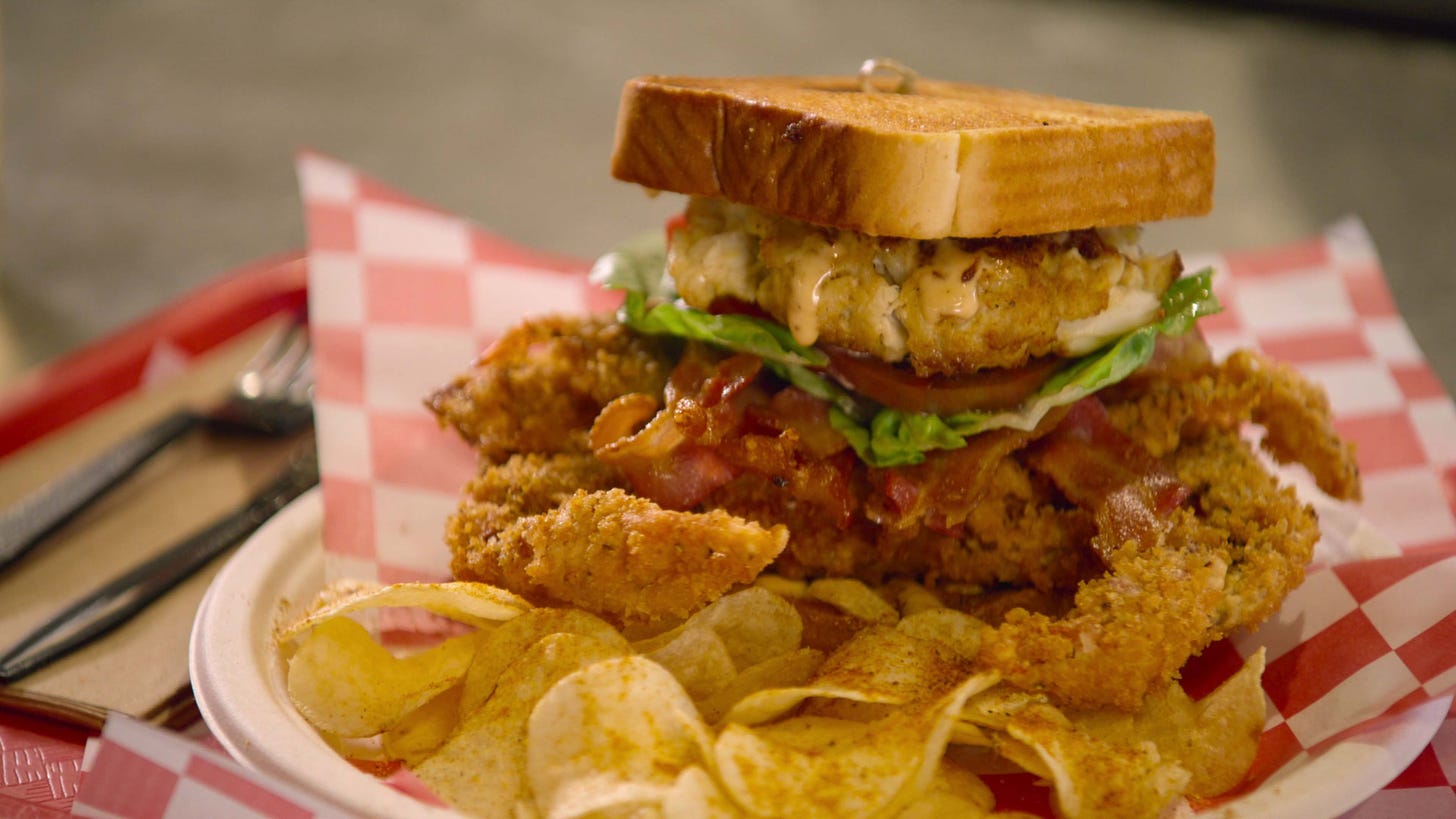#13 Indomie Goreng – Snack & Chill
This edition of the Cosy Delicious newsletter features a savoury lunch-quickie with Indonesian roots, a truly beautiful Ukrainian cookbook, a zine about cake, and more. Stay cosy!
🤌🏻 Try this at home, kids!
It’s not lost on us that a food-related newsletter couldn’t be more trivial these days, completely insignificant even. With wars and hate crimes raging worldwide and turning the internet into an ugly, divisive place, we acknowledge that it feels strange to concern oneself with culinary pleasures. Yet it seems all the more essential to take the opportunity to show up for one another and care for the people around us.
Resilience, as Sonja learnt in a design education workshop the other day, can’t be taught; it is mainly built through “together experiences” and strongly linked to the way we foster relationships. Friendly conversations around a shared meal enhance resilience.
We invite you to read this little newsletter as a reminder to appreciate togetherness and food with your loved ones. Maybe even a plate of Homemade Indomie Goreng.
Indomie Goreng is more than just a packet of instant noodles; it’s a cultural emblem that packs a punch of flavours, much like the essence of Indonesia itself. The twirl of each noodle strand carries the legacy of a nation that takes its food seriously. From Duy Anh’s days as a student, where pimping up a pack of Indomie with eggs, leftover meats, and herbs was almost a rite of passage for him, to adulthood, where this practice holds a nostalgic yet gourmet appeal, it’s clear that Indomie is a pretty versatile buddy in our pantry.
The convenience and adaptability of this humble noodle have made it a cherished item across dining tables in Asia. And while the packet version offers a quick noodle fix, our recipe is about to add a sprinkle of home-cooked love to this iconic dish.
Get started:
Let your egg noodles soak for half an hour in lukewarm water.
In the meantime, chop your veggies (half a cabbage, two carrots, garlic, onions) and your greens (chives, cilantro, thai basil).
Mix your Indomie Goreng sauce:
4 tbsp Ketjap Manis
1 tbsp soy sauce
1 tbsp dark soy sauce
3 tbsp Heinz ketchup
1 tbsp sesame oil
2 tbsp oyster sauce
1 tbsp sambal
1 tbsp chicken powder (the Asian one)
1 tbsp hot water
Now, you can drain your noodles and add a few drops of sesame oil so they won’t stick; their consistency will be on the chewy side but turn soft when pan-fried later on.






Let’s get this cooking:
Step by step, fry all your ingredients; start with the veggies – carrots, garlic, cabbage, and shallots. Take it all out once it’s nicely browned. Continue with your prawns; sear them until the skins glow brightly red for at least 2 or 3 minutes per side. Put aside.
Heat a generous amount of oil. Then, fry chopped scallions until the oil becomes nice and fragrant. Add your drained noodles and stir in the Indomie Goreng sauce, spoon by spoon (not all at once).
Set up a separate pan with enough oil to deep-fry the eggs.
Now, let’s assemble it all. Mix your veggies and prawns with the fried noodles, and place on a plate. Add a fried egg or two to each plate, garnish with a generous amount of fried shallots and your freshly chopped cilantro, thai basil and chives. (You will soon notice that the chives are the secret star of this little show!)






This is your shopping list for about 3-4 portions to copy-paste if you don’t have those ingredients already:
Egg noodles, carrots (2-3), cabbage (1/2), chives, cilantro, Vietnamese basil, garlic, shallots, scallions, prawns (12-15 pieces) Ketjap Manis, soy sauce, dark soy sauce, Heinz Ketchup, sesame oil, oyster sauce, olek, chicken powder.
💕 You know what this tastes amazing with!?
SevenUp
👀 So apparently, you’re into summer recipes, are you?
Our friend Lisa brought us this book as a gift a while back; it had first been published in 2020. “Summer Kitchens” by renowned author Olia Hercules presents itself as a mesmerizing exploration of Eastern Europe’s rich culinary tapestry and how it’s linked to its past. The narratives and creativity of Ukrainian cuisine seem deeply rooted in the will to persevere despite wars and hardship.
At the heart of “Summer Kitchens” lie the, duh-uh, summer kitchens, which line the landscapes of Eastern Europe. They serve not just as places to cook but as vessels of tradition and memories, where families preserve the bounties of summer to sustain them through the harsh winter months. Hercules ingeniously uses these structures as a captivating lens to view Ukraine’s diverse cuisine and heritage.
This cookbook presents readers with a sumptuous array of 100 recipes that showcase the diversity of Ukrainian cuisine, reflecting the unique landscapes, climates, and locally sourced ingredients. Each recipe is meticulously crafted to provide an authentic taste of Ukraine, from hearty dumplings to aromatic stews, delicate pastries and refreshing salads. Hercules’ deep-rooted connection to her homeland is palpable in every dish she presents, ensuring that each one is a testament to her passion for her heritage.
By now, you’re probably aware that we’re also here for the design side of food things: “Summer Kitchens” is a visual feast adorned with a beautiful collection of images that transport readers to the heart of Ukraine, offering a poignant glimpse into the culture, traditions, and memories that have shaped its cuisine.
📺 Worthwhile to watch
This is a bit of a guilty pleasure: Netflix’s “Fresh, Fried and Crispy” follows food critic and journalist Daym Drops’s dive into the world of fried food all over the USA. His expedition combines a deep-fried culinary adventure with a heartfelt look at the people and places behind these delectable dishes, taking viewers on a coast-to-coast tour. From the crispy chicken in Memphis to mouthwatering mozzarella sticks in Buffalo, this show is a tribute to the art of deep frying.
What sets this show apart is the genuine passion and enthusiasm Daym Drops brings to every episode. His infectious excitement and charming personality make him a delightful guide through the world of fried delicacies, whether sizzling hot shrimp or the gooey cheese oozing from a sandwich. (As always, our recommendation is not to watch this hungry…)
📍 Here’s a hotel recommendation for you
“What does it mean to live well, to enjoy oneself, while still making responsible choices?” reads the current Design Hotels magazine Directions editorial, this issue being subtitled “A new hedonism”. It was the first thing Sonja saw lying in a hotel room of The Comodo she shared with our friend Lisa in August. Their aim: taking a girls’ trip to indulge in what was then called “responsible hedonism”, as per the above-quoted editorial.
This meant many bubbly drinks and exquisite meals were shared, in-between strolls were taken, and the pool was frequented before ordering more culinary treats. The hotel’s kitchen boasts a sustainable farm-to-table approach with freshly sourced ingredients from local farmers and producers. (Still daydreaming about one of their artful desserts, a honey-lemon mousse with elderflower ice cream and baked white chocolate crunch. Yums!)
The Comodo proved perfect for a little mountain getaway with a solid train connection between Munich-Bad Gastein, yet enough remoteness and nature to feel adventurous. Not too adventurous, of course, we mainly came to stay indoors and inspect the acclaimed interior design. This place definitely lives up to its hype!









🏆 If you like us, you’ll love
Cake Zine. This account belongs to the indie publishers of New York City-based Cake Zine, a meticulous and highly clever independent print magazine exploring society through sweets, which Sonja discovered through her Stack Magazines subscription. Volume 3, the “Humble Pie” issue, features, among other things, a flaky-savoury Đặc Biệt’s recipe, tries to demystify the all-American origins of the infamous “Japanese Fruit Pie”, sings an ode to the deep-fried gas station cherry pie, and much more. We’re fans!
💌 A random quote on food
“The food is often what we look forward to most in a celebration, and what most cements our memories.”
Ruth Barry, Black Isle Baking
✌🏻 Who are we even!?
We’re a journalist slash a designer by day and foodies by night. Sonja has spent around 15 years in hospitality (big love!), and Duy Anh learned his craft mostly by watching his talented mum whip up the most amazing Vietnamese meals. So when we cook, it’s all about that sweet spot between cosy and delicious. Although admittedly, our days of the extravaganza have changed pace ever since our harshest critic (aka now two-year-old daughter) came into our lives. Hence the delay with the promised cookbook. We’ll keep you posted!
🎤 Lastly, let’s turn to our foreign correspondent Alice M. Huynh
Our foodie partner in crime, Alice M. Huynh, has a special treat for this issue: Co Do Hue is a Vietnamese venue that spoils hungry visitors with a variety of freshly prepared traditional dishes, some of which are specifically from the Huế region.
Her secret tip: the steamed rice cakes, Bánh bèo, that are usually topped with velvety mung bean, prawn floss, fried pork fat, and a drizzle of scallion oil for the perfect combination of flavour and texture. “Bánh bèo is a speciality that I crave when I need that unique Vietnam feeling,” says Alice. “Not Phở, not Bún chả or Bánh mì. Just these simple, round, steamed rice cakes topped with shrimp and crispy onions, dipped in a delicious and strong nước mắm châm.” Alice knows what she’s talking about when she says that Co Do Hue’s fish sauce dipping sauce is one of the best she’s ever had. There you go!



🍳 What’s next?
We hope you liked what you read and will try some of it. We’d love for you to tune in again in two weeks. Until then, stay cosy! 💋










